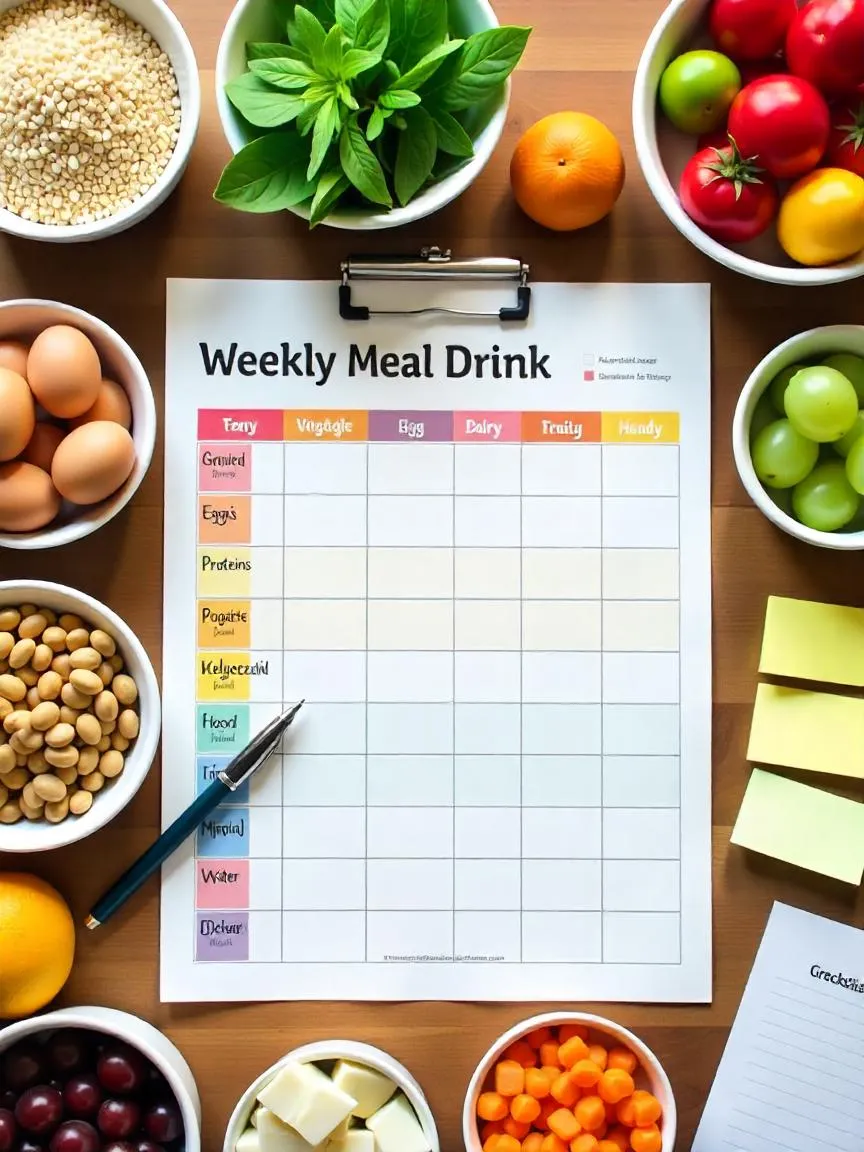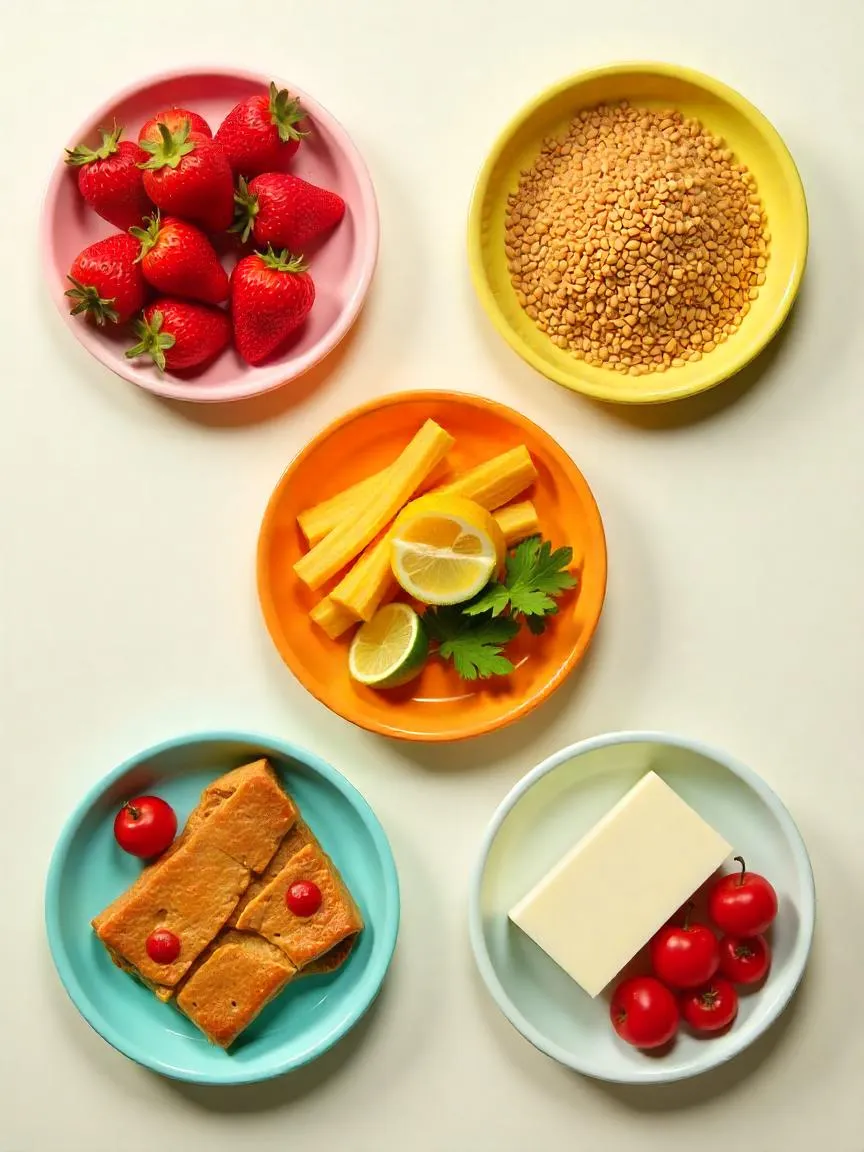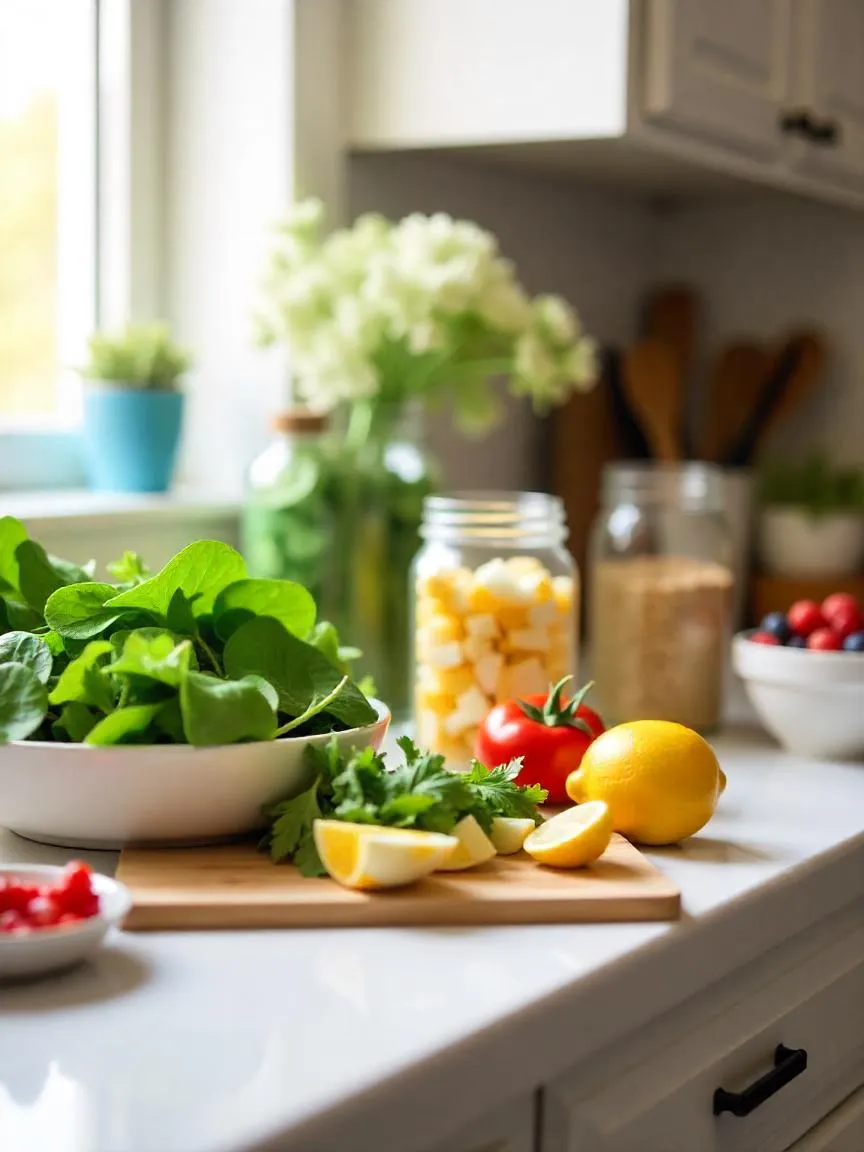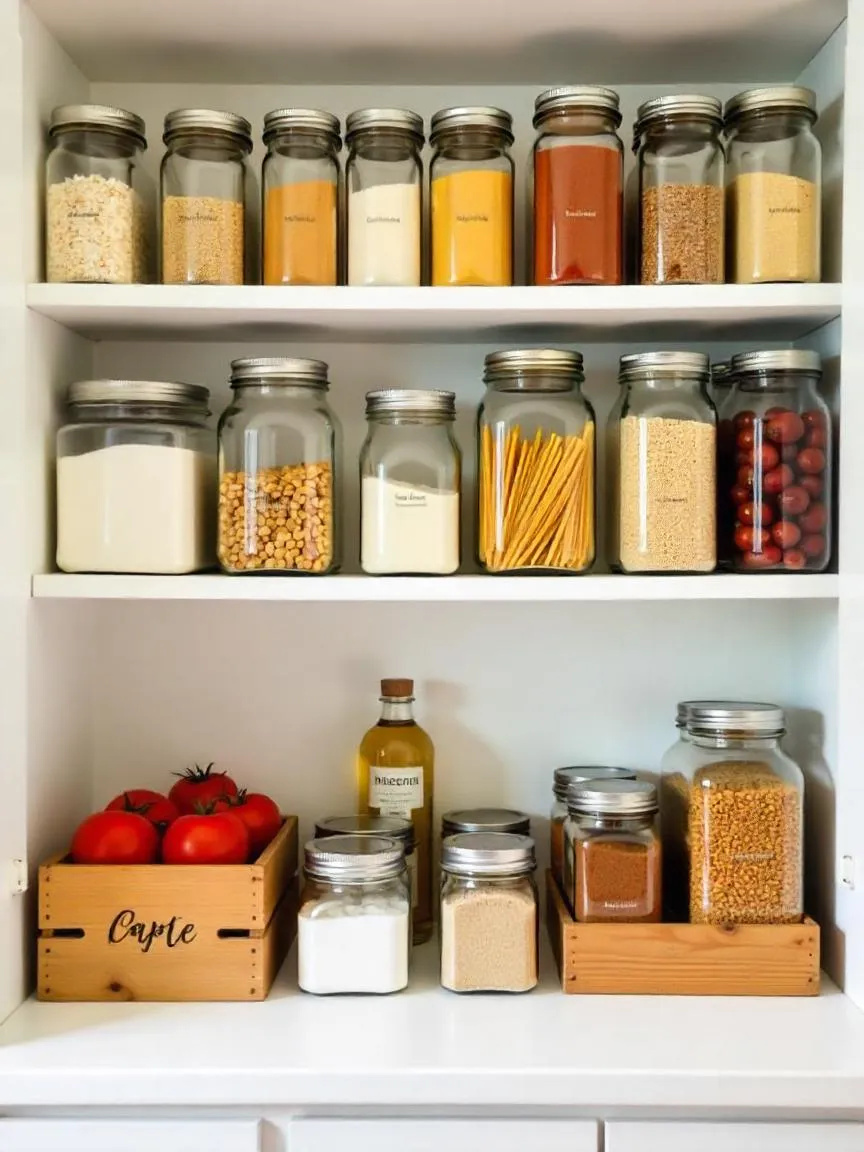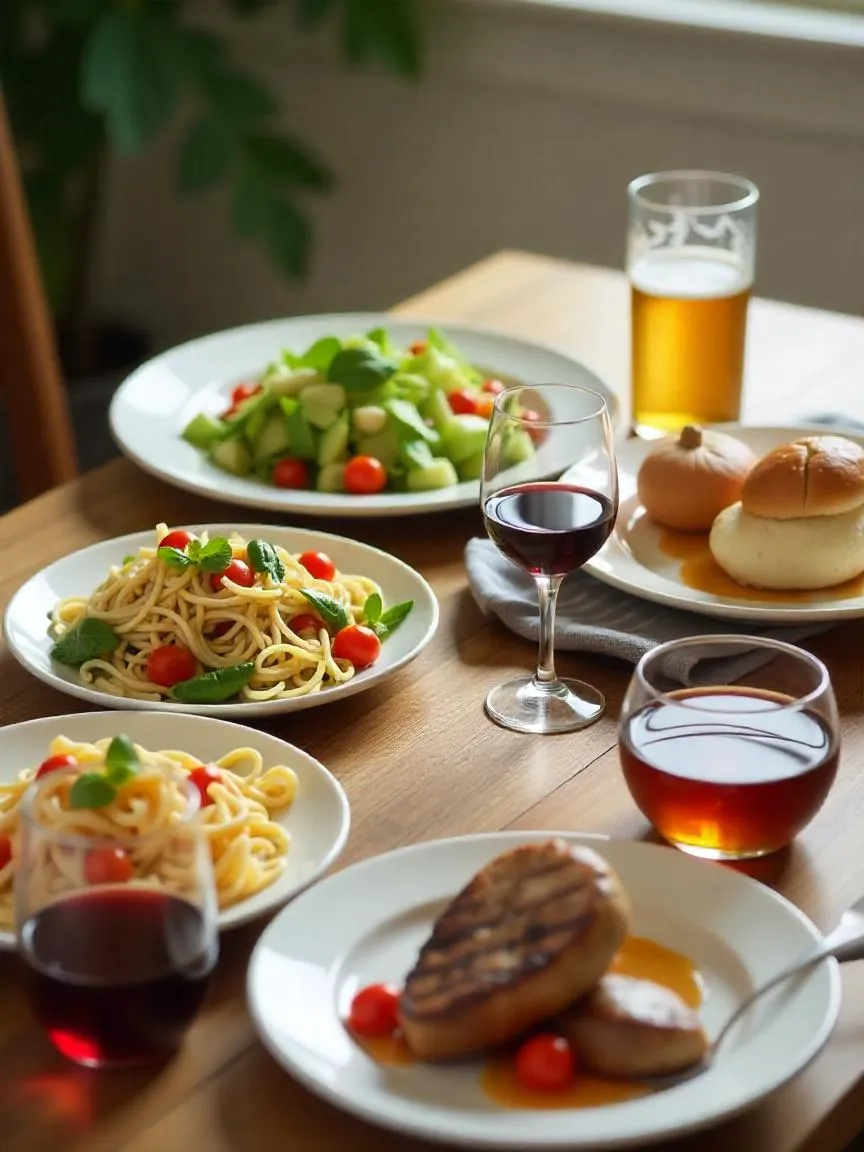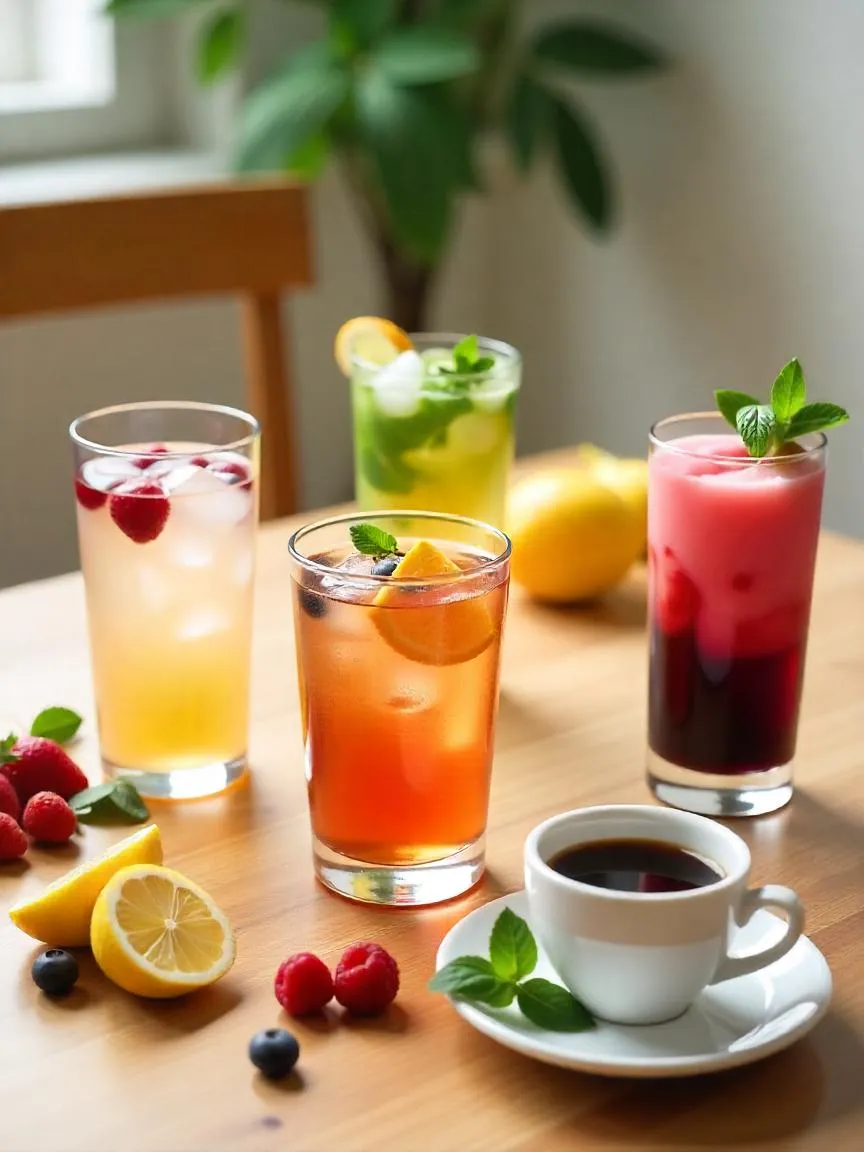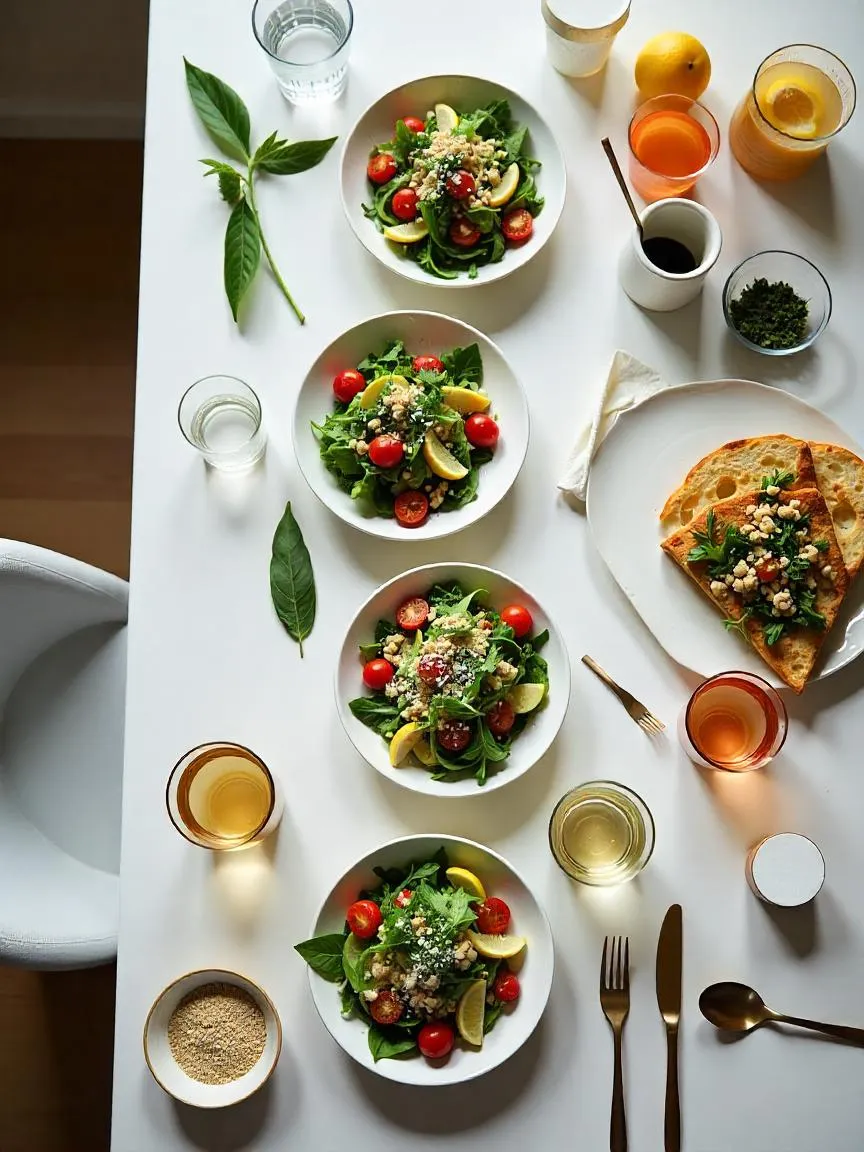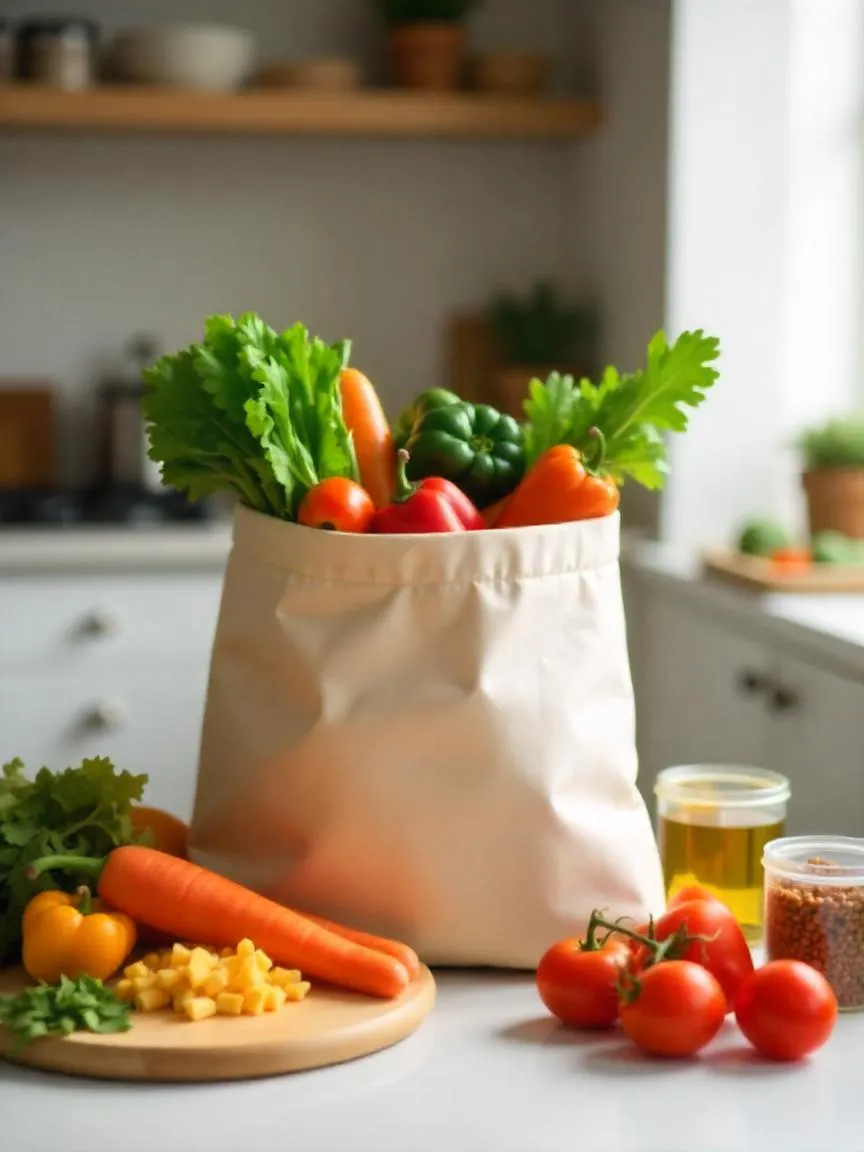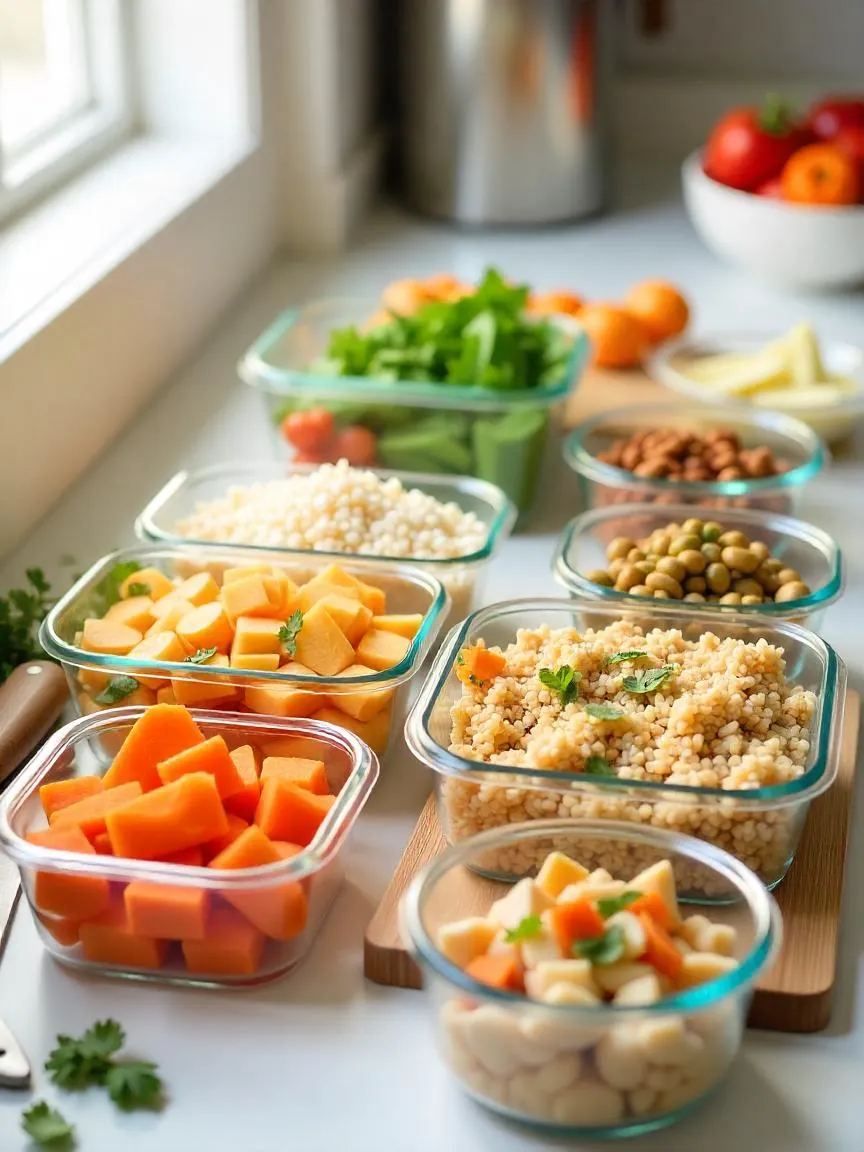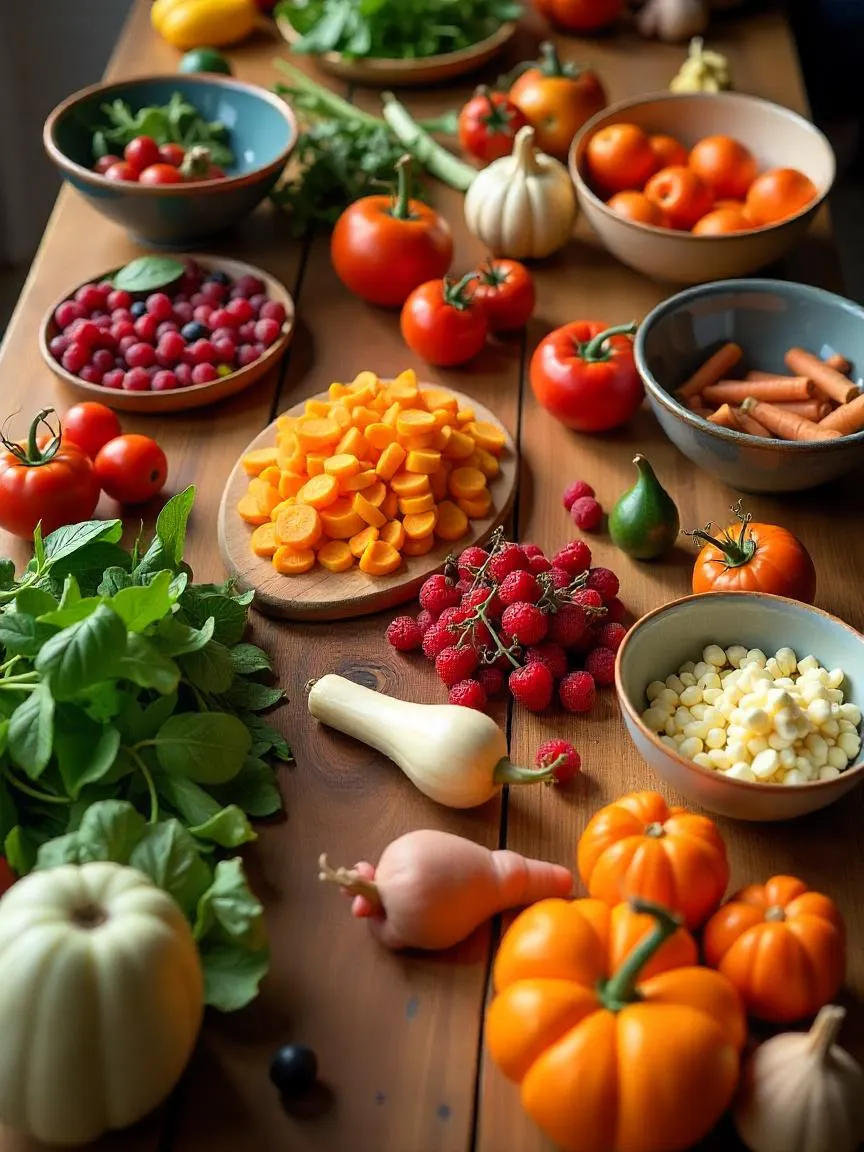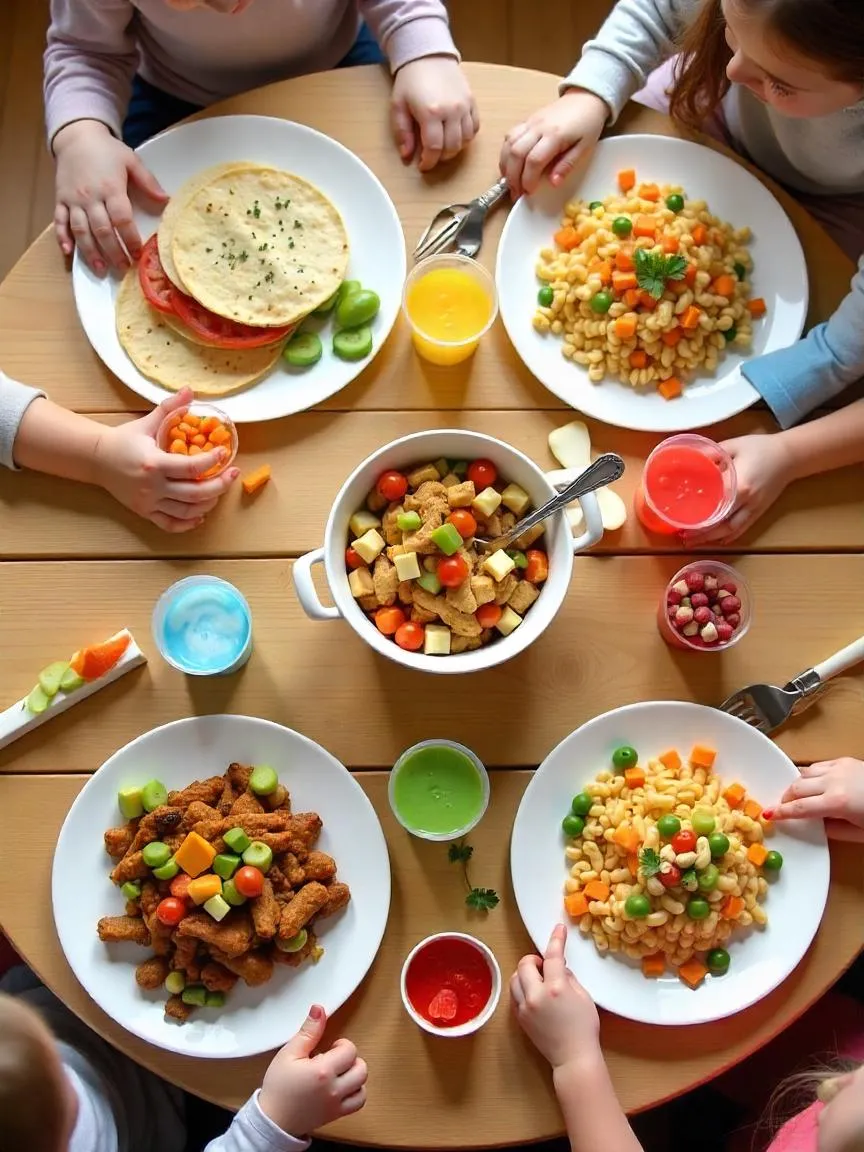Contents
- 🧩 Meal Planning Basics: How to Build a Balanced Week of Food and Drinks
- 🎯 Setting Nutritional Goals: The Foundation of Smarter Meal Planning
- 🏡 Essential Pantry Staples: Your Meal Planning Lifesavers
- 🍽️ Organizing Food and Drink Options: Pairing for Balance, Flavor & Flow
- 📅 Creating Weekly Menus: A Smarter Way to Eat, Sip & Stay Sane
- 🛒 Smart Shopping and Prep: How to Save Time, Eat Better & Cut Waste
- 🎨 Creative Ideas for Meal Planning: Keep It Fresh, Fun & Family-Friendly
- 👨👩👧👦 Family-Friendly Recipes & Healthy Snacks: Keep Everyone Fed and Happy
Finding time to eat well during the week can feel like a challenge — but with a little planning, it doesn’t have to be. Meal planning for both food and drinks is a smart, time-saving strategy that helps you eat healthier, stress less, and stay energized — even on the busiest days.
Instead of wondering “What’s for dinner?” or reaching for quick fixes, a solid plan helps you:
✅ Make faster grocery trips
🥗 Stick to balanced, nutritious choices
💸 Save money by avoiding last-minute takeout
Whether you’re juggling work, family, or personal goals, having a weekly menu with easy meals and drink pairings helps you stay on track — and feel better day to day.
Meal planning is especially helpful if you’re:
Managing a busy schedule
Supporting a health or fitness goal
Cooking for multiple people
Trying to simplify your routine
By creating a short list of go-to meals, snacks, and drinks, you remove the daily guesswork. Add in a few simple recipes, some prep shortcuts, and suddenly… it’s not overwhelming — it’s empowering 🍽️✨
🧩 Meal Planning Basics: How to Build a Balanced Week of Food and Drinks
Meal planning is more than just writing down what’s for dinner — it’s a way to take control of your nutrition, time, and budget. Whether you’re cooking for yourself or a whole family, building a simple weekly plan helps make everyday eating less stressful and more intentional.
At its core, meal planning involves:
- 🗓️ Choosing what to eat and drink for each day in advance
- 🍴 Including a variety of foods from different groups
- 🧊 Keeping key ingredients and staples stocked and ready
- 🎯 Aligning with your nutrition, health, or energy goals
A good plan doesn’t have to be complicated. With just a little effort, you can make sure your meals are both balanced and satisfying — without standing in front of the fridge every night wondering what to make.
🥦 Understanding Food Groups: The Building Blocks of Every Meal
To plan healthy, well-rounded meals, it helps to start with the five main food groups, each offering different nutrients your body needs to function at its best:
🍓 Fruits and Vegetables
Packed with vitamins, minerals, antioxidants, and fiber. Try to include a variety of colors and types every day — fresh, frozen, or cooked.
🌾 Grains
A key source of energy and fiber. Choose whole grains like brown rice, oats, or whole wheat bread over refined ones when possible.
🍗 Protein
Includes meat, poultry, seafood, eggs, beans, lentils, tofu, nuts, and dairy. Protein helps repair tissues, build muscle, and keep you full.
🥛 Dairy or Dairy Alternatives
Rich in calcium, vitamin D, and protein. This group includes milk, yogurt, cheese, or fortified plant-based alternatives like almond or oat milk.
🥑 Fats
Not all fats are bad — in fact, healthy fats from avocados, olive oil, nuts, and seeds are essential for brain health and hormone balance.
🧠 Tip: When planning meals, aim to include something from at least 3 food groups per meal — this keeps your plate balanced and your body fueled.
🎯 Setting Nutritional Goals: The Foundation of Smarter Meal Planning
Meal planning works best when it’s guided by clear, realistic nutritional goals. Whether you’re trying to eat cleaner, boost your energy, or manage a specific health condition, having goals gives your food choices purpose and direction.
Instead of guessing what to eat each day, you’ll have a roadmap — helping you create meals that are not only convenient, but actually aligned with your well-being and lifestyle.
✅ Common Nutritional Goals You Can Set
Start simple. Choose goals that feel achievable and meaningful for your daily life. Examples include:
- 🥦 Eat more vegetables — Aim for at least 5 servings a day, mixing raw and cooked options
- 🥤 Drink more water — 6–8 cups per day is a great baseline for most people
- 🍬 Reduce added sugars — Cut back on soda, packaged snacks, and sugary sauces
- 🧃 Limit processed foods — Swap in whole ingredients where possible
- 🍗 Increase protein intake — Especially at breakfast and lunch to support energy and muscle health
- 🧂 Watch sodium and saturated fats — Choose low-salt, heart-healthy options when available
📊 Use Serving Targets to Stay Balanced
One helpful strategy is to set a target number of servings from each food group per day. For example:
- Fruits & Vegetables: 5–9 servings
- Whole Grains: 3–6 servings
- Lean Proteins: 2–3 servings
- Dairy or Alternatives: 2–3 servings
- Healthy Fats: small amounts daily
Tracking these servings (even roughly) can make a big difference in how balanced and nourishing your meals feel throughout the week.
🎯 Why This Matters:
Nutritional goals give you clarity and confidence when meal planning. They help avoid extremes (like too much sugar or not enough protein), and they support long-term energy, focus, and wellness.
🏡 Essential Pantry Staples: Your Meal Planning Lifesavers
A well-stocked pantry is one of the biggest time-savers when it comes to meal planning. Having key ingredients on hand means you can whip up quick, balanced meals without last-minute grocery runs or takeout temptation.
These everyday staples are versatile, long-lasting, and form the foundation for dozens of easy recipes — from soups and stir-fries to snacks and sauces.
🧂 Must-Have Pantry Items for Quick, Healthy Meals
Here’s a breakdown of pantry MVPs to keep stocked:
🥫 Canned Goods
- Beans (black, chickpeas, kidney): High in fiber and protein
- Diced tomatoes & tomato paste: Great for sauces, soups, stews
- Coconut milk or broth: Useful for curries, grains, and creamy dishes
🌾 Grains & Carbs
- Brown rice, quinoa, or couscous: Nutritious, quick-cooking bases
- Whole grain pasta or noodles: Great for last-minute meals
- Rolled oats: Perfect for breakfast or baking
🧴 Oils & Condiments
- Olive oil, avocado oil: For cooking, dressings, and marinades
- Soy sauce, vinegar, mustard, hot sauce: Flavor boosters
🌿 Herbs & Spices
- Garlic powder, paprika, cumin, basil, oregano: Add depth without extra calories
- Salt & pepper: Pantry musts
🥜 Nuts, Seeds & Dry Snacks
- Almonds, walnuts, sunflower seeds: Great for snacking or topping meals
- Nut butters: High-protein spreads or smoothie additions
🧠 Why It Matters:
With these staples ready to go, you’ll always have the base for a fast, flavorful meal — no stress, no panic-shopping. They also help reduce food waste and support more mindful meal planning.
🍽️ Organizing Food and Drink Options: Pairing for Balance, Flavor & Flow
Meal planning isn’t just about what you’ll eat — it’s also about how everything fits together. By taking a few extra minutes to think through how your meals and drinks will pair, you can turn your weekly menu into something that’s not only practical… but also deliciously satisfying.
When you balance flavor, texture, and timing, you make meals more enjoyable — whether you’re planning for one person or a full dinner table.
🥂 Balancing Meals with the Right Drinks
A thoughtful drink pairing doesn’t have to be fancy — it just needs to complement the food, not compete with it. Here are some simple tips to guide your choices:
🥗 Light Meals → Light Drinks
- Salads, seafood, or grilled veggies pair best with:
– Sparkling water with citrus
– Iced herbal teas
– Crisp white wines like Sauvignon Blanc
– Light beer or kombucha
🍝 Hearty Meals → Bold Sips
- Pasta dishes, red meats, creamy sauces match well with:
– Red wine (Cabernet, Merlot)
– Dark ales, stouts, or root beer
– Infused water with warming spices (like cinnamon or ginger)
– Zero-proof cocktails with depth (like mock sangria)
🍰 Sweet Treats → Smooth Companions
- Desserts are enhanced by:
– Light coffee or espresso
– Dessert wines or sweet liqueurs
– Flavored milk or tea lattes
– Chilled milk alternatives with vanilla or cocoa
🤝 Offer Variety to Suit All Preferences
Not everyone drinks alcohol — and that’s perfectly fine. It’s a good idea to include both alcoholic and non-alcoholic options in your weekly plan or dinner setup. Consider:
- 🍹 A sparkling mocktail with fruit and herbs
- 🍷 Alcohol-free wine or beer for social occasions
- 🧊 Infused waters (lemon-cucumber, strawberry-basil)
- ☕ Warm drinks like spiced tea or golden milk for cozy meals
This keeps things inclusive, flexible, and flavorful — and makes it easy for everyone to enjoy what’s on the table.
🧠 Pro Tip: When planning a week of meals, think of your drinks like side dishes — they should match the mood, enhance the flavor, and support the goal of the meal (refreshing, comforting, energizing, etc.).
📅 Creating Weekly Menus: A Smarter Way to Eat, Sip & Stay Sane
Designing a weekly menu isn’t just for chefs or big families — it’s one of the easiest ways to simplify your week, reduce decision fatigue, and make grocery shopping faster and cheaper. Plus, it makes meals more exciting when you plan for both food and drink pairings.
Whether you’re cooking daily or just trying to stop relying on takeout, starting with 3–4 dinners per week is a great way to ease in. You’ll avoid burnout and still enjoy structure.
📝 How to Build a Weekly Menu (Without the Stress)
- Pick your focus meals: Dinners are a good starting point. Add breakfast or lunch only if you want extra structure.
- Add drink pairings: Choose drinks that fit the mood — refreshing for light meals, bold for hearty dishes.
- Use a calendar or meal planner: Even a sticky note or digital app works. Include prep steps or defrost reminders if needed.
- Keep a mix: Combine homemade meals, leftovers, and easy staples like frozen dumplings, canned soup, or boxed pasta.
- Stock versatile drinks: Juice, soda water, flavored tea, or your favorite wine can round out most meals without daily trips to the store.
🍴 Mixing & Matching Flavors: Pair Like a Pro
Pairing food and drinks isn’t just about tradition — it’s about contrast and harmony. The right combination makes flavors shine and elevates the whole meal. Try experimenting with:
- 🔥 Spicy food + sweet drinks (like tacos + sangria)
- 🧂 Salty snacks + bitter drinks (like popcorn + IPA)
- 🍫 Rich desserts + bold drinks (like brownies + port)
Here’s a sample flavor pairing chart to guide you:
| Food Type | Drink Pairing |
|---|---|
| Cheese & Crackers | Whiskey or dry cider |
| Grilled Chicken | Light beer or lemonade |
| Spicy Noodles | Sweet white wine or tea |
| Chocolate Desserts | Red wine or port |
| Veggie Stir-Fry | Green tea or sparkling water |
💡 Tip: Keep track of favorites in a simple notebook, phone app, or magnet chart on the fridge. It makes future planning faster — and tastier.
🛒 Smart Shopping and Prep: How to Save Time, Eat Better & Cut Waste
Smart meal planning doesn’t end in the kitchen — it starts at the store. A thoughtful shopping routine helps you buy only what you need, reduce food waste, save money, and cook with ease throughout the week.
By prepping ingredients in advance and shopping with intention, you’ll spend less time wondering “What’s for dinner?” — and more time actually enjoying your meals.
📝 Grocery List Strategies That Work
A clear, well-organized grocery list is one of the most powerful tools for meal planning success. Here’s how to make it work for you:
✅ 1. Take Inventory First
Before writing your list, check your pantry, fridge, and freezer. Do you already have rice, canned beans, pasta, or frozen veggies? Build meals around what you already own to save money and space.
🥗 2. Plan Around Real Meals
Instead of writing random ingredients, list what you plan to cook (e.g., “chili” → ground turkey, black beans, tomatoes, onion). This ensures everything on your list has a purpose.
🧠 3. Add Nutritional Variety
Include all food groups:
- Fresh fruits and vegetables
- Whole grains (brown rice, oats, quinoa)
- Lean proteins (chicken, tofu, eggs, legumes)
- Healthy fats (olive oil, nuts, avocado)
- Drinks or beverages to pair with meals
Throw in one or two “new-to-you” items to keep things exciting, like a seasonal vegetable or a new spice blend.
🛍️ 4. Group by Store Section
Organize your list like the store layout to cut down time and avoid zig-zagging:
| Section | Examples |
|---|---|
| Produce | Carrots, spinach, apples |
| Dairy | Milk, yogurt, cheese |
| Protein | Eggs, chicken breast, tofu |
| Grains | Pasta, oats, bread |
| Snacks/Other | Nuts, hummus, sparkling water |
💰 5. Stick to Your Budget
Lists help avoid impulse purchases. Compare prices on essentials, and buy in bulk for pantry staples when it makes sense.
🧼 Prep Smarter, Not Harder
Once you’re home from the store, take 20–30 minutes to prep:
- 🧺 Wash and chop veggies
- 🍚 Pre-cook grains or proteins for the week
- 🥫 Portion snacks or ingredients into containers
- 🧊 Label and freeze anything you won’t use soon
A little work up front means faster meals, less stress, and fewer spoiled ingredients later in the week.
🧑🍳 Prepping Ingredients Ahead: Cook Less, Eat Better
One of the smartest ways to simplify weekday cooking is to prep ingredients in advance. With just a little time up front, you can make meals faster, reduce stress, and avoid relying on unhealthy convenience food.
Here’s how to make prep work for you:
🔪 What to Prep in Advance
- Wash & chop vegetables like carrots, peppers, cucumbers, and leafy greens
- Pre-cook grains such as rice, quinoa, or bulgur for quick add-ins
- Marinate proteins (like chicken, tofu, or tempeh) a day ahead to boost flavor
- Portion snacks like nuts, trail mix, or fruit into containers
- Blend sauces or dressings for the week in advance
Prepping also helps with portion control — a major win for anyone managing calories or trying to eat more mindfully.
👨👩👧👦 Tip: Turn prep time into family time — assign simple tasks to kids or partners to share the load and make it fun!
🧊 Storing Food and Beverages: Keep It Fresh, Keep It Safe
Proper storage not only keeps food fresher for longer — it also makes your kitchen more organized and your prep time more efficient.
🥬 Fresh Produce Tips
- Fridge: Berries, leafy greens, broccoli, carrots
- Counter: Bananas, tomatoes, onions, citrus
- Cool, dark storage: Potatoes, garlic, winter squash
📦 Use clear containers for prepped ingredients so you can see what’s inside at a glance. Bonus points for labeling with the prep date!
🥡 Leftovers
- Cool them quickly after cooking
- Store in airtight containers
- Use within 3–4 days or freeze for later
- Label with date and contents to avoid surprises
🧃 Beverages
- Milk, juice, and plant-based drinks last longer when stored cold and tightly sealed
- Avoid placing them near the fridge door, where temps fluctuate more
- Keep drinks away from strong-smelling foods like garlic or onions to preserve taste
✅ Good storage habits = less waste, fewer spoiled ingredients, and smoother cooking all week long.
🎨 Creative Ideas for Meal Planning: Keep It Fresh, Fun & Family-Friendly
Meal planning doesn’t have to feel like a chore. In fact, the more creative you get, the easier (and tastier) it becomes. By rotating seasonal ingredients, building a list of family-favorite recipes, and sneaking in healthy snacks and drinks, you can turn your weekly plan into something you actually look forward to.
This approach adds variety, reduces food boredom, and makes the most of what’s available — especially if you’re on a budget or shopping local.
🥕 Incorporating Seasonal Produce
One of the simplest ways to keep your meals fresh and full of flavor is to cook with what’s in season. Seasonal fruits and vegetables are usually:
- 🟢 Fresher – harvested at peak ripeness
- 🧡 More flavorful – nature’s best-tasting moment
- 💰 Budget-friendly – lower prices due to higher availability
- 🌍 Eco-smart – less shipping and packaging, more local impact
🛒 Check your local farmers’ market, community-supported agriculture (CSA) box, or even grocery store sale flyers to see what’s in season.
🗓️ Sample Seasonal Ideas by Season
| Season | In-Season Produce | Meal Ideas |
|---|---|---|
| Spring | Asparagus, peas, radishes | Spring veggie stir-fry with lemon dressing |
| Summer | Tomatoes, berries, corn | Caprese salad, berry yogurt parfait |
| Fall | Squash, apples, sweet potatoes | Roasted root veggie bowl, apple crisp |
| Winter | Kale, citrus, carrots | Hearty lentil soup with lemon + kale |
Keeping a running list of favorite seasonal ingredients and go-to recipes makes planning faster over time — and makes weeknight meals feel far from routine.
💡 Pro Tip: Seasonal meals don’t have to be fancy — even something simple like grilled peaches in summer or baked apples in fall can elevate an everyday dinner.
👨👩👧👦 Family-Friendly Recipes & Healthy Snacks: Keep Everyone Fed and Happy
Mealtime gets a lot easier — and more enjoyable — when meals work for everyone at the table. With the right recipes and a few smart snack options, you can keep things tasty, nutritious, and stress-free even on the busiest days.
🍽️ Easy Meals Everyone Will Love
Family-friendly meals are flexible, familiar, and easy to customize. Look for recipes that:
- Use simple, recognizable ingredients
- Can be adapted for different tastes or dietary needs
- Involve build-your-own or mix-and-match elements
Here are a few go-to favorites that work across all ages:
- Pasta with hidden veggies (blend spinach, carrots, or cauliflower into the sauce)
- Build-your-own tacos or burrito bowls
- Chicken or tofu stir-fry with rice or noodles
- Mini homemade pizzas using flatbreads or pita
- Sheet pan meals — one pan, less cleanup!
👩🍳 Bonus idea: Designate one night a week as “Family Cook Night.” Let the kids stir, choose toppings, or wash veggies. It builds skills and memories.
🥒 Healthy Snacks and Drink Ideas
When snack time is planned, it’s easier to avoid last-minute grabs like chips or candy. Stock your kitchen with easy, grab-and-go snacks that fuel energy and support good habits.
🥗 Snack Ideas:
- Fresh fruit (apples, grapes, oranges)
- Cut veggies + hummus or yogurt dip
- Whole-grain crackers with cheese
- Plain popcorn
- Greek yogurt with berries or honey
🧃 Smart Drink Options:
- Water (add lemon, mint, cucumber, or berries for flavor)
- Herbal teas (chilled or warm)
- Milk or fortified milk alternatives
- Homemade smoothies or fruit-infused iced tea
- Limit soda, juice blends, or sugary sports drinks
📦 Tip: Store snacks in clear containers at eye level — in the fridge or pantry — so healthy choices are the easiest to reach.
🍽️ By keeping meals flexible and snacks accessible, you’ll make your meal planning work for real life — with less stress, more balance, and happy tummies all week long.


